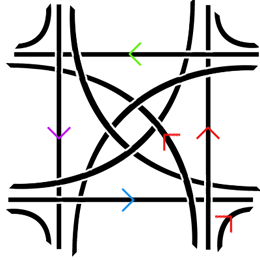An Interchange
(Originally published on September 22, 2010)
Here is my version of a stack interchange — a system of two highways intersecting such that cars coming from any direction can either go straight, turn right onto the intersecting highway, or turn left in the opposite direction of the intersecting highway (I didn’t allow U-turns so as not to complicate things too much).
My highway interchange: the red arrows show the paths that drivers going in a particular direction could take. Note that at most two lanes intersect at a point which makes it conceivable to build the interchange with two levels only; in the diagram the broken lane is below the other
And here is a slightly different version that doesn’t suffer from the problem of a center being too dense — if you look very carefully, you’ll see that in the version above, the centers of each of the arcs would meet unless the drop is not uniform.
Addressing the problem of a dense center
It seems to me that it can be built with two levels only — although something makes me think that it’s not that viable to build (since existing stack interchanges require four or more levels), plus to ensure a practical speed it would either have to have a rather large surface area, or only allow passenger cars driving with reduced speed. Here it is in three dimensions:
My stack interchange in three dimensions
My stack interchange, zoomed in. The lane splits into three lanes and each separate lane takes you into one of the three directions
You can download my Google SketchUp file here .



